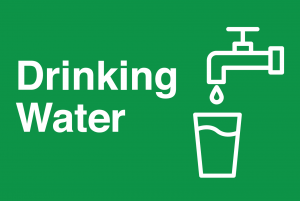
 Since 2007, the Ontario government has been requiring child care centres and schools to flush the plumbing in their facilities and test drinking water for lead.
Since 2007, the Ontario government has been requiring child care centres and schools to flush the plumbing in their facilities and test drinking water for lead.
New amendments to Ontario Regulation 243/07, which took effect July 1, 2017, require lead testing within these facilities for all fixtures used to provide drinking water and/or prepare food or drink for children under 18.
For individual school results or questions about the testing, please contact:
Matt Gibbs, Occupational Health & Safety Specialist
[email protected] or 905.527.5092, ext. 2218
Ontario Drinking Water Quality Standard
The Ontario drinking water quality standard for lead is 10 micrograms per litre. You may also see this standard written as 10 μg/L or as 0.010 milligrams per litre.
Drinking Water Fixture Signs
Drinking water fixtures such as food prep sinks, that are meant to provide water for consumption or for food preparation, will be labelled with a sign illustrating that the water is provided for drinking purposes. Water fountains will not have these signs as their intended purpose is for drinking.
Procedures if Results are Above Provincial Standards
If a child care centre or school receives a lead test result above the Provincial Standards, HWDSB follows the requirements set out in Ontario Regulation 243/07 to protect our students. Hamilton Public Health Services is also consulted and may provide additional guidance on corrective actions necessary to ensure the safety of our students.
After corrective action (may include flushing, repair, removal/replacement of the fixture) and re-testing shows that the fixture is within Provincial Standards, the board consults with Public Health before allowing the use of the drinking water fixture by our students.
Ontario Regulation 243/07 Questions and Answers
Q. What is the drinking water quality standard for lead?
A. The Ontario drinking water quality standard for lead is 10 micrograms or 0.01 milligrams per litre.
Q. How is water sampled for lead and how often does this sampling take place?
A. The Board follows O.Reg 243/07 for lead sampling in schools. Under this Regulation, there are timelines for all drinking water fixtures to be sampled in both elementary and secondary schools. Once all drinking water fixtures have been sampled at least once, schools are able to able to return to sampling one drinking water fixture annually.
To sample for lead, two one-litre samples are taken. These samples include:
1) Standing sample – collected after water has been sitting in the pipes overnight.
2) Flushed sample – collected after the drinking water fixture has been flushed for at least five minutes and turned off and left unused for at least 30 minutes but not more than 35 minutes.
Q. What happens when there is an exceedance for lead?
A. Exceedances for lead are reported to Hamilton Public Health Services and the Ministry of the Environment, Conservation and Parks. If the exceedance is on a standing sample, the school is moved to daily flushing of all drinking water fixtures. If the exceedance is on a flushed sample we immediately remove that fixture from service and begin actions to address the issue. Each situation is unique and involves investigation, remediation and verification through two sets of resamples. Once the acceptable results are achieved, the fixture is returned to service. This is done with guidance from Hamilton Public Health Services. The Ministry of the Environment, Conservation and Parks will follow up with the Board and local Medical Officer of Health if necessary.
Q. How does lead get into the drinking water?
A. Lead pipe service connections have been used to deliver water from distribution pipes since the late 1800s. Older buildings, generally those built before the mid-1950s are more likely to have lead components. Extended contact between standing water and the components can cause the lead to be released from the pipes.
Q. Why flush the drinking water fixtures?
A. Flushing has been shown to reduce lead levels in drinking water fixtures. By flushing fixtures, water that may have come into contact with lead over an extended period of time is replaced with fresh water.
Q. Am I able to view reports from the lead sampling?
A. Yes, if you are interested in viewing the lead samples reports for your school, please speak with the principal. If you would like more information on reading the reports, a guideline is available.
Q. Where can I go for further information?
A. You can always direct your questions to the school’s principal. If you are interested in further web resources on lead, please visit the resources for more information below.
Resources for more information
Updated on Friday, June 14, 2024.

